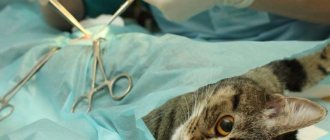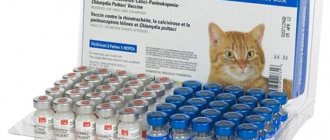Mustachioed pets are a joy for every home. But all cat owners sooner or later face the issue of sterilization. This is a medical procedure that is absolutely safe for animals and is successfully performed by veterinarians all over the world. Our Murkosha shelter also sterilizes all animals, since we are against reproduction. Today there are so many homeless kittens on the streets. Cats give birth to dozens of babies, and for owners, housing such a huge number of kittens becomes simply an impossible task.
That's why we sterilize all animals ourselves before sending them to the Murhappy Project for adoption, and we recommend that anyone who wants to get a kitten do the same.
At what age are male cats sterilized?
The question of when can a cat be sterilized is asked by every owner who decides to operate on their pet. The most favorable period for sterilization is considered to be when the kitten is already fully formed, but the time for the first heat has not yet come. Castration of cats (complete removal of reproductive organs) is contraindicated before one year of age.
The best age for sterilization is 7-12 months. Animals can be sterilized until they reach 10 years of age (provided there are no pathologies).
It should be remembered that during sexual desire, the cat’s body produces hormones in large quantities, which accumulate in the body if mating does not occur. Over time, a cat may develop diseases of the reproductive system, including cancer. The cat may lose its appetite and become aggressive. Therefore, the earlier the operation is performed, the better.
Castration of animals over 10 years old is also carried out if there are medical indications. But the older the cat, the higher the likelihood of complications.
Differences between sterilization and castration
Many people mistakenly believe that cats are always spayed, and cats are always sterilized. But that's not true. Castration and sterilization can be performed on both sexes. The differences are that during castration, the gonads are removed - the testes in males and the ovaries and uterus in females. When spaying cats, only the ovaries are removed. But since people are accustomed to using the term “sterilization” for cats and “castration” for cats, veterinarians often use this terminology, still implying castration.
Today, castration is a more popular method, since uterine cancer is a common disease in animals. Therefore, there is no point in leaving this organ to the cat, especially since it does not perform any functions.
Therefore, in this article we will talk specifically about castration, but for the convenience of readers, in the future the term “sterilization” will be used in relation to cats.
Read more: “Why is it necessary to sterilize cats?”
Where is it better to perform the operation: in a clinic or at home?
The operation is best performed in a veterinary clinic. The quality depends on how and where the cat is sterilized. Advantages of the hospital:
- complete disinfection of the premises using bactericidal lamps and antiseptic solutions;
- availability of all necessary equipment in the operating room;
- the ability to provide emergency medical care that requires special equipment;
- inpatient observation of the animal for 8-12 hours after surgery, monitoring the pet’s recovery from anesthesia (not in all clinics);
- presence of specialists.
If the operation is carried out at home, the owner must independently provide the conditions for the operation - carry out disinfection, provide a workplace (hard, durable surface). Not everyone can provide all this fully. It is possible that the owner will have to act as an assistant. Caring for the animal after the procedure falls entirely on his shoulders.
But if a simple operation is required (castration of a cat), or if the animal experiences panic when leaving the house or visiting a clinic, then an operation at home would be a suitable option.
The truth about cat sterilization
Sterilization of cats is an operation to remove the reproductive organs of females (ovaries, uterus), due to which the animal’s sexual desire for the opposite sex disappears and the ability to breed is completely lost.
Why sterilize animals?
Surely, everyone who has kept or keeps a cat in their home, sooner or later faces a problem when, from a calm, balanced pet, at one point the animal turns into a creature constantly screaming and yelling day and night all day long. Such a time becomes a real test for the owners. Sleepless nights and constant meowing force owners to choose what to do with a helpless animal, because listening and looking at all this becomes unbearable.
Is there an alternative?
Some people run to the nearest pet store for “magic” tablets or drops, after using which, as if by a wave of a magic wand, the animal quickly calms down and the owners begin a calm and joyful life again. Other owners, turning to a veterinarian for help, give the cat a hormonal injection, which suppresses the occurrence of sexual arousal for a long period of time from 3-6 months to 1 year. And finally, some of the owners, in my opinion the smallest part of them, go to veterinary clinics for cat sterilization surgery.
Do cats need sterilization?
Let's figure out which choice is preferable. Puberty in cats occurs at 7-8 months of age. For some, this period begins at an earlier age, at 5-6 months. At this time, the cat’s gonads (ovaries) begin to actively secrete sex hormones – estrogens
.
Under their influence, the cat develops that “abnormal” behavior that we are all accustomed to seeing and which worries the owners so much. Depending on the animal’s temperament, the duration and activity of the period of excitation can vary and usually range from several days to 1-2 weeks. During this period, all the reproductive organs of the animal, at the call of nature, begin to prepare for conception and gestation. If the cat is not mated, then she calms down, and in her body one sex hormone is replaced by another - progesterone
, thanks to which happy, calm days begin in her life and in the lives of her owners. It is customary to say about such a cat that she “wasted.” The number of such “empties” can reach several times a year, although it is generally accepted that cats are dicyclic animals (the manifestation of the sexual cycle is observed 2 times a year). This period in a cat’s life is biologically very difficult and forces the animal to experience enormous stress. Constant “empties” throughout the animal’s life and interruption or change in the course of the sexual cycle, as many owners prefer to do, using “magic” pills or drops, or a hormonal injection, have a detrimental effect on the health of the pet in adulthood, and sometimes even in the first years of life. years of life.
All this leads to irreversible consequences and the occurrence of such terrible diseases as endometritis, pyometritis (purulent inflammation of the uterus), glandular cystic endometrial hyperplasia, ovarian cysts, malignant formations
etc. To avoid the above health problems for cats, most veterinarians insist on performing cat sterilization operations. This is an absolutely harmless surgical procedure, the quality of the result of which depends mainly on the experience of the doctor.
From all of the above, the conclusion suggests itself: when you buy a kitten or an adult cat, decide for what purpose you are taking it. Either she will be a caring mother for her future offspring, but then a huge responsibility for the fate of the kids will fall on your shoulders, so that when they grow up they will find reliable owners who will care and love them. Or the cat will simply become a good and loyal friend for you, and expecting offspring from it is not part of your plans. In this case, make sure that your cat lives a calm, healthy and happy life, for which it is necessary to perform an operation to sterilize the animal. Do not harm the health of the animal by using contraceptives and dooming it to painful suffering and possibly death.
At what age is it preferable to have surgery?
So, we have determined that the operation of sterilizing cats is not only harmless, but also useful for those animals that are not used for breeding. Let's now look at the question of the favorable time for the operation. This is one of the questions that is often asked by visitors to our clinic who are planning to have surgery on their animal. Among a large number of animal owners, breeders and veterinarians, there is an opinion that any cat must produce offspring at least once in its life in order to feel healthy and happy for the rest of its life. Based on my own experience and the opinion of most veterinarians, I want to assure you that this is not the case. Moreover, early sterilization has a beneficial effect on the cat’s health and even prolongs its life. The optimal age for surgery on a young animal is from 5-6 to 7-8 months. This is the period of life before the first signs of puberty appear. In simple terms - until the moment when the cat began to roll on the floor, meow loudly and protractedly and try to run away into the street.
Preparation period
The process of the preparatory period will differ in what age and physiological state the animal is in. Here we can distinguish the period before puberty, the period after puberty at a young age, the period of mature and old age.
At a young age, when the cat has not yet experienced all the delights of puberty, by the time of the sterilization operation she must be clinically healthy, she must be vaccinated against infectious diseases no later than 3-4 weeks before the operation, and she must also be aged on a 12-hour fasting diet.
In adulthood, after the onset of puberty, it is preferable to carry out sterilization surgery during the animal’s calm period, when all the symptoms of excitement are not pronounced, so as not to expose the pet to additional stress. The animal must also be clinically healthy, vaccinated, and kept on a 12-hour fasting diet.
As for preparing a mature and elderly animal, this process, as a rule, takes more time and effort for both the owner and the pet itself. By this time, many cats develop hidden pathologies of the body that, during an external examination, the doctor may not identify, and therefore may not assess the degree of risk to the health and life of the animal. In order to maximally protect the animal from the undesirable consequences of the operation, the doctor prescribes a more detailed examination, which includes: a clinical blood test, a biochemical blood test, a general urine test, ultrasound, ECG, x-ray.
. Based on the results of the examination, provided there are no hidden pathologies, the surgeon makes a decision to prescribe or refuse surgery. If the decision is made in favor of sterilization surgery, then immediately before it the cat is also kept on a 12-hour fasting diet.
Features of the sterilization operation
The preparatory period is over, the cat is healthy, vaccinated, has passed all the necessary tests and is on a 12-hour fasting diet. Only after this the animal is sent to the operating table. When carrying out an operation to sterilize cats, all rules of asepsis and antiseptics are observed - surgical instruments and material are boiled and disinfected. The operating room is disinfected, the operation is carried out strictly with sterile gloves. The doctor gives the animal several injections, after which it falls asleep. The surgical field is prepared (the required area of hair is shaved, followed by disinfection, and a sterile napkin is applied). The operation begins.
There are two methods of surgical access: in the middle part of the abdomen (along the “white line”, below the navel), with a layer-by-layer incision of the skin, subcutaneous tissue and peritoneum; in the lateral part of the abdomen, with an incision in the skin, subcutaneous tissue, separation of muscles and fascia, and an incision in the peritoneum. In our clinic, operations of this kind are usually carried out “along the white line”. This is due to the ease of access to the operated organ, the large volume of the operated area, and good, smooth healing of the incision. The operation is performed either with the removal of only the ovaries (ovarioectamy) or with the removal of the ovaries and uterus (ovariohysterectomy). The choice of one method or another is mainly related to the age of the animal. If the cat is young, has not given birth, and best of all, has not reached puberty, then the first method is used. But if the animal is mature or elderly and has had repeated births, then the second method is preferable in order to reduce the risk of cancer and purulent diseases in the uterus in the future. The operation is successful, the surgeon applies stitches, and a bandage is put on the animal - a postoperative blanket. To prevent postoperative complications, an anesthetic and antibacterial drug is given. This cat sterilization operation, from anesthesia to suturing, takes an average of 30 to 45 minutes.
Postoperative period
The operated animal must be placed on a waterproof bedding, since, while under anesthesia, it does not control its physiological processes. Until the cat wakes up, you need to constantly (every 7-10 minutes) moisten its eyes by closing the eyelids. Otherwise, the cornea of the eye may dry out and inflammation may occur. At home, the cat should be placed on the floor in a well-ventilated room. From the end of the operation to the awakening of the animal, an average of 30 minutes to 2-3 hours passes. Immediately after the cat regains consciousness, it will most likely be eager to go somewhere, try to jump onto a high place, or hide in secluded places. Don't let her move too much, much less jump. Some owners hold their pet in their arms throughout the entire awakening period.
After anesthesia, animals often feel cold, so it is better to cover them with a sheet or light blanket. Feeding on this day should be completely excluded, but water should be available constantly. The first day after the operation is the most important for the owners, so it will be better if on this day other matters are put aside and all your attention is given to the cat. From the second day, as food for the animal, it is best to use ready-made dietary highly nutritious food from premium or super-premium companies: Royal Canin, Proplan, Hills, thanks to which the functioning of the gastrointestinal tract is restored, the general condition improves and the animal quickly recovers.
Also, the day after the sterilization operation, the animal must be given an anesthetic injection and the stitches treated with an antiseptic (hydrogen peroxide 3%). The sutures must be treated daily until the doctor removes them. Sutures are removed 8-10 days after surgery. During this period, the cat should be in a blanket to prevent licking and gnawing at the seams. At first, while the animal is in the bandage, it may not feel comfortable, constantly lie down, try to remove it, some animals back away. After removing the blanket, usually after the stitches are removed, the pet’s activity and mood are completely restored.
Sterilization, in most cases, does not in any way affect the character and behavior of the animal, but some owners note that the animals become calmer, gentle and affectionate.
Find out the cost of sterilizing cats at the ZooVet Veterinary Clinic.
Types of sterilization
There are several methods for sterilizing cats:
- Ovariectomy. This is removal of the ovaries. An incision is made in the abdominal cavity, the ovaries are removed, and internal (self-absorbing) and external sutures are applied (removed after a week). Suitable for young nulliparous cats without uterine pathologies.
- Tubal occlusion. The fallopian tubes are ligated. The cat will no longer be able to get pregnant. But the ovaries will continue to function, the estrous cycle will not stop.
- Medication. Use of hormonal medications. Serves to stop estrus. There is a risk of developing tumors of the genital organs.
- Ovariohysterectomy. Complete removal of the uterus and ovaries. It is used to detect diseases of the reproductive system.
- Laparoscopy. Instead of incisions, punctures are made. An instrument with a built-in video camera and lighting is inserted through these holes. The image is transferred to the screen. No bandage or antibiotics are required after the procedure. The method is suitable for everyone, especially older cats.
- Radiation. The animal is exposed to radioactive radiation. An unsafe method - cells of neighboring tissues may be damaged, and oncology may develop.
The most effective and safest types of cat sterilization are those that are most often used in the clinic where castration will be performed. Doctors have enough experience in this case, which will reduce the risk of complications.
Consequences and possible complications
In some cases, it is not possible to wait for this process to complete. Then you need to be prepared for the possible consequences of the operation:
- Heavy blood loss.
- Inflammatory processes.
- Diseases of the genitourinary system and ovaries.
- Hormonal disorders.
- Long-term restoration of hormonal balance.
- Psychological stress.
- Lengthy rehabilitation.
Accordingly, there is a danger when performing this procedure: severe complications may occur; Sterilizing a cat during heat, the consequences of which can be unpredictable, is undesirable. It is better to postpone it to a more favorable period.
Preparing for surgery
The duration of preparation depends on the age at which the cat is sterilized. All vaccinations must be completed at least 21 days before surgery. The exception is the presence of diseases. If necessary, the doctor prescribes tests and ultrasound. 10 days before sterilization, it is necessary to carry out deworming, treatment for fleas and lice. Stages of preparation for surgery:
- Preventative examination by a veterinarian 2 days before the procedure.
- Setting a date and time.
- Nail trim the day before.
- 12 hours before surgery, food intake is stopped.
- Stop drinking liquid 3 hours before the procedure.
Food and water should not be given because after the administration of anesthesia, vomiting is possible with a full stomach. Vomit can enter the respiratory tract and cause infection in the bronchi. Bacteria cause aspiration pneumonia. The animal's body, weakened after surgery, is not able to resist infection. The disease will lead to the death of the pet.
When is the best time to spay after estrus?
Contraindications to surgery can be determined depending on the well-being, age and health of the pet. If you have a weakened immune system or heart problems, you should postpone the procedure, as extra stress on an already weak body can lead to undesirable consequences.
Many people are interested in the question of when to sterilize a cat after estrus. It is best to sterilize an animal a week after the final completion of this process. During this procedure, the pet is exposed to stress, so it is not advisable to operate on it.
Veterinarians recommend surgery before the onset of the first heat, since the individual has not yet reached puberty. Thus, there will be no significant changes in her behavior after such a procedure.
Cat behavior after surgery
After laparoscopy, cats recover quickly, within a few hours (after the anesthesia wears off). The animal's behavior remains the same as before sterilization.
With the cavity method, cats take longer to recover. The longest and most difficult process is after the removal of the uterus and testicles. When the anesthesia wears off, your pet may be lethargic and apathetic and display aggression. Animals refuse to eat, may try to remove the bandage, or chew through the stitches. They don’t recognize the owner, they hiss and attack. Cats sleep a lot in the first 24 hours after anesthesia and do not eat anything. They are thirsty.
The reproductive system of cats is fully formed by 5 months. You can castrate a kitten already at this age, but veterinarians do not recommend doing it so early. Kittens do not tolerate anesthesia well, and complications from the cardiovascular system are possible in the future. Cro
In addition, kittens that had surgery too early are lagging behind in growth and development compared to their peers.
Optimal age for intervention
Animal lovers often wonder whether it is possible to sterilize a cat while walking. It's best to do this as early as possible. For example, recommended age:
- 8 months;
- 10 months;
- 1 year;
- 1.5 years.
Babies easily tolerate sterilization, complications are rare
By completing the procedure at eight months, the owner is guaranteed to solve the problem of unwanted pregnancy once and for all. However, animal owners are often afraid that too early intervention can harm the fragile body. These fears are unfounded. If the cat is healthy, no problems should arise. The main thing is to follow all the recommendations of the attending veterinarian.
Important! Difficult childbirth is much more dangerous for a young female.
The younger the animal, the easier it will tolerate the effects of anesthesia.
Postoperative care
Postoperative care for your cat includes the following:
- providing the animal with complete rest;
- treating sutures with an antiseptic before removing them;
- forced watering with a syringe several hours after recovery from anesthesia (if the animal does not drink on its own);
- control of the position of the bandage.
If an incision was made rather than a puncture, the cat is given a post-operative bandage or blanket. After recovering from anesthesia, the animal may be aggressive and try to throw off the bandage. We must not let him do this. To relieve aggression, it is recommended to give Kot Bayun drops according to the instructions for use.
After anesthesia, cats need to drink plenty of fluids. If after a few hours the cat refuses to drink on his own, you need to give him something to drink from a syringe. There is no need to force-feed, you can give broth (beef, chicken). In the first 3 weeks after the procedure, you should be given reduced portions of food to reduce the stress on the sutures and prevent their dehiscence.
A visit to the veterinarian is required within 24 hours. He will monitor the condition of the animal, give recommendations on the treatment of stitches and putting on a bandage.
It is important to understand what sterilization in cats is. This is a surgical intervention that can lead to the following complications after surgery:
- excessive weakness;
- Sopor;
- depression;
- bleeding from the genitals or intestines;
- increased or decreased body temperature;
- nausea, vomiting;
- shortness of breath, difficulty breathing;
- unsteadiness of gait;
- trembling, convulsions;
- diarrhea or constipation;
- redness or pallor of mucous membranes;
- going without food and water for too long.
If you detect at least one of these signs, you should immediately consult a doctor.
Changes in physiology and behavior
The first heat or estrus begins in cats after the completion of puberty at 6–10 months, in large breeds later.
From this moment on, it repeats regularly, accompanied by hormonal surges and behavioral changes. The reproductive cycle consists of the following stages :
- The preparatory period , proestrus , lasts 2–3 days. Under the influence of the gonadotropic hormone of the pituitary gland, the growth of ovarian follicles begins, and the secretion of estrogen increases. The uterus swells, its walls thicken, and a liquid transparent secretion is released. The reproductive system prepares for mating and ovulation. The pet becomes excited, fawns over its owners, meows, scratches surrounding objects, but does not let the cat near.
- The second stage , estrus , lasts 6–7 days. The concentration of estrogen increases, the uterus prepares to accept and store the embryo. The female makes guttural sounds, inviting a partner, crouches to the floor, raises her tail, and walks on bent legs. She runs to the litter box more often, marks her territory, hardly eats, and drinks a lot. The vulva enlarges, clear mucus without blood is secreted, which the animal licks. During mating, the secretion of luteinizing hormone increases, which stimulates the rupture of follicles. After ovulation, the amount of estrogen decreases sharply. The ovaries form the corpus luteum, which secretes progesterone. Under its influence, the endometrium thickens, and the uterus awaits the embryo. Fertilization occurs 1–2 days after mating.
- The third stage , metestrus , lasts 8 days. After ovulation, the sexual instinct dies out, the female ceases to be interested in cats, and behavior returns to normal. If fertilization does not occur, the concentration of progesterone drops, and physiological changes are repeated in the reverse order. Sometimes an animal begins to have a false pregnancy. If the female does not meet a partner and mating does not occur, the cycle repeats after 3 weeks.
At the end, the resting phase begins - anestrus; this happens more often in the winter season, when daylight hours are reduced, lasting from 3 weeks to 3 months. Hormonal levels are stabilizing.
Pros and cons of the procedure
Many people wonder whether cats need to be sterilized. You need to know what advantages the procedure has:
- eliminates the risk of developing diseases of the reproductive organs and genitourinary system, including cysts, malignant tumors, and breast cancer;
- there is no need to fear ectopic pregnancy and complications during childbirth;
- beneficial effects on the mental and emotional state of the pet;
- getting rid of the state of constant stress in which an uncastrated animal finds itself;
- This is the most humane way to get rid of unwanted offspring.
When asking a veterinarian why to sterilize a cat, many note the disadvantages of the operation:
- The procedure is dangerous for some breeds - Maine Coons, British and Scottish Folds, Sphynxes. Cats of these breeds are prone to hypertrophic cardiomyopathy. Anesthesia is fraught with the formation and separation of blood clots with subsequent blockage of blood vessels.
- Obesity may develop in the future. The pet's physical activity decreases and appetite increases.
- Risk of medical errors.
- The risk of infection by viruses and bacteria with the subsequent development of inflammatory processes if sanitary conditions are unsatisfactory (when performing surgery at home).
Each owner decides for himself whether he needs to sterilize his cats.
What to do when a cat marks during heat
The female attracts male cats with her scent and voice. She marks while standing, her tail rises and trembles. At this moment, a stream of urine and a secretion with a pungent odor are released. This is how the cat expresses its readiness to mate. Behavior is fixed at the genetic level, so it is useless to punish, educate, or lock up a pet. Isolation increases stress and leads to mental illness.
The behavior of a female can be changed in two ways: drug regulation and sterilization. To reduce sexual activity, 2 types of drugs are produced: herbal and hormonal. The former contain herbal extracts, therefore they are safe, and are found in the form of drops and tablets. These include Anti-stress, Cat-Bayun, Stop-stress.
Medicines calm the pet, but do not affect the instincts. Reviews from cat owners confirm the low effect during estrus. Some animals are temporarily calmed by Feliway. It contains an artificial substitute for facial gland secretions and is available in the form of a spray and diffuser.
Hormonal preparations are created on the basis of a synthetic substitute for progesterone and are produced in the form of tablets and solutions for injection. Medicines suppress sexual desire, prevent or stop estrus, prevent conception, the effect of the drugs lasts up to six months. At the same time, they undermine the health and shorten the life of the pet.
Serious consequences come with age:
- uterine pathologies develop: endometriosis, purulent inflammation of the pyometra;
- cysts form in the ovaries;
- the functioning of the heart and blood vessels is disrupted, thrombosis develops;
- the functions of the nervous system are disrupted, which causes behavioral deviations: lethargy or aggression, convulsions, drowsiness;
- diabetes and kidney failure develop;
- Malignant formations of the mammary glands, ovaries, and uterus occur.
It is a mistake to consider hormonal pills less harmful than injections. Complications occur later and manufacturers simply keep silent about them. In veterinary medicine in European countries, the use of synthetic hormones is prohibited by law.
Cost of the operation
The cost of the operation depends on the complexity of the technique, the level of the veterinary clinic, and the cost of the medications used. The fee for inpatient observation during the day after the procedure and calling a veterinarian to your home is taken into account separately.
The cheapest operation is castration of a cat. Prices start from 800 rubles. You can sterilize or castrate a cat for a price starting from 1,200 rubles. The answer to the question of how much it costs to sterilize cats can be found by contacting the clinic.
All information posted on the site is provided in accordance with the User Agreement and is not a direct instruction to action. We strongly recommend that before using any product, you must obtain a face-to-face consultation at an accredited veterinary clinic.
Signs of estrus
To attract males, females use 2 tools: voice and smells. All sounds made become rougher and louder. Frequent but light urination occurs not only in the litter box - the pet leaves odorous marks on vertical and horizontal surfaces. Raising her tail and turning her back towards the target, she secretes a few drops of urine.
Another way to place marks is by rubbing them on objects. The glands on the cheeks of furry pets secrete a special secretion, allowing them to leave an individual scent.
The signs of the first menstruation are identical to subsequent ones. They are distinguished only by their weak expression in young animals.
Remember that discharge during “critical days” should be transparent. The appearance of blood or pink clots is a dangerous symptom that requires diagnosis.











